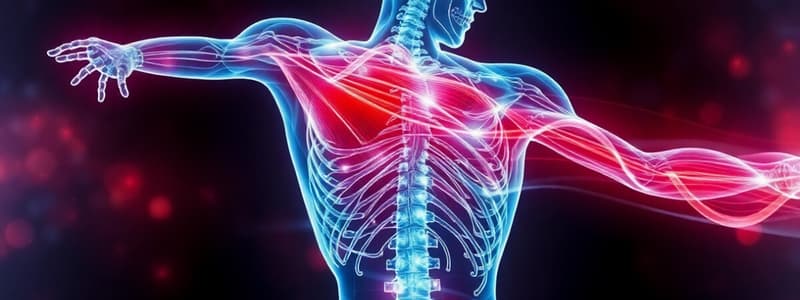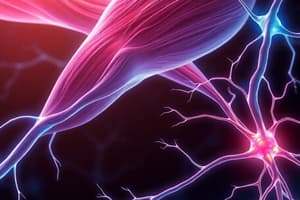Podcast
Questions and Answers
What function of skeletal muscle is least dependent on its connections to other tissues?
What function of skeletal muscle is least dependent on its connections to other tissues?
- Movement
- Stability
- Heat generation (correct)
- Protection of organs
Which muscle type does not contract spontaneously?
Which muscle type does not contract spontaneously?
- Skeletal muscle (correct)
- Cardiac muscle
- Smooth muscle in digestive tract
- Smooth muscle in blood vessels
What is the role of Ca2+ in the muscle action potential?
What is the role of Ca2+ in the muscle action potential?
- Depolarisation
- Repolarisation
- None - Ca2+ only regulates contraction (correct)
- Hyperpolarisation
What is the role of T-tubules in skeletal muscle function?
What is the role of T-tubules in skeletal muscle function?
A motor unit containing few muscle fibres produces:
A motor unit containing few muscle fibres produces:
Curare completely blocks cholinergic transmission at the neuromuscular junction. It will therefore cause:
Curare completely blocks cholinergic transmission at the neuromuscular junction. It will therefore cause:
When a whole motor nerve is stimulated electrically, increasing strength of stimulus causes the muscle to contract more strongly. Why is the all-or-none law apparently not obeyed?
When a whole motor nerve is stimulated electrically, increasing strength of stimulus causes the muscle to contract more strongly. Why is the all-or-none law apparently not obeyed?
Which organs are capable of generating heat?
Which organs are capable of generating heat?
What component of a sarcomere does the I-band represent?
What component of a sarcomere does the I-band represent?
What component of a sarcomere does the A-band represent?
What component of a sarcomere does the A-band represent?
Which of the following correctly describes the sarcomere during contraction?
Which of the following correctly describes the sarcomere during contraction?
If a muscle is stretched until the zone of overlap disappears, it:
If a muscle is stretched until the zone of overlap disappears, it:
At the molecular level, the energy source for contraction is:
At the molecular level, the energy source for contraction is:
The energy-dependent rotation of the myosin head during muscle contraction is responsible for:
The energy-dependent rotation of the myosin head during muscle contraction is responsible for:
What is the first step in the contraction of a skeletal muscle fibre?
What is the first step in the contraction of a skeletal muscle fibre?
What is the role of the sarcoplasmic reticulum in skeletal muscle?
What is the role of the sarcoplasmic reticulum in skeletal muscle?
During excitation-contraction coupling, troponin binds Ca2+. How does this enable contraction to occur?
During excitation-contraction coupling, troponin binds Ca2+. How does this enable contraction to occur?
While Ca2+ is present in the sarcoplasmic reticulum:
While Ca2+ is present in the sarcoplasmic reticulum:
During peak activity muscles cannot generate enough energy (ATP) from oxygen-dependent metabolism. What happens in this situation?
During peak activity muscles cannot generate enough energy (ATP) from oxygen-dependent metabolism. What happens in this situation?
Accumulation of lactic acid in contracting skeletal muscle is also called the 'oxygen debt'. What does this mean?
Accumulation of lactic acid in contracting skeletal muscle is also called the 'oxygen debt'. What does this mean?
Flashcards are hidden until you start studying
Study Notes
Skeletal Muscle Function
- Heat generation is the least dependent function on connections to other tissues.
- Movement, stability, and protection of organs rely on connections to other tissues, such as bones, tendons, and ligaments.
Muscle Types
- Skeletal muscle doesn't contract spontaneously, while cardiac muscle, smooth muscle in the digestive tract, and smooth muscle in blood vessels do.
Ca2+ Role in Muscle Action Potential
- Ca2+ is not involved in the muscle action potential itself.
- It plays a crucial role in regulating muscle contraction.
T-Tubules Function in Skeletal Muscle
- T-tubules are responsible for ensuring quick and even excitation of the muscle.
- This is achieved by rapidly distributing the muscle action potential throughout the muscle fiber.
Motor Unit and Muscle Movement
- A motor unit with few muscle fibers produces fine movements, while a motor unit with many muscle fibers produces powerful movements.
Curare and Neuromuscular Junction
- Curare completely blocks cholinergic transmission at the neuromuscular junction.
- This results in complete paralysis and relaxation of the muscle.
All-or-None Law and Motor Units
- The apparent violation of the all-or-none law is explained by the presence of multiple motor units within a motor nerve.
- Increasing stimulus strength activates additional motor units, leading to stronger contractions.
Organs Capable of Generating Heat
- Skeletal muscle and the liver are the primary organs responsible for generating heat.
- The gastrointestinal tract, nervous system, and lungs also contribute to a lesser extent.
Sarcomere Components
- The I-band represents the portion of thin filaments on both sides of the Z-line that don't overlap with thick filaments.
- The A-band encompasses the entire length of the thick filaments, including the region where thick and thin filaments overlap.
Sarcomere During Contraction
- During contraction, the A-band remains constant.
- The I-band gets smaller, and the Z-lines move closer together.
- The zone of overlap increases.
Muscle Stretch and Contraction
- If a muscle is stretched until the zone of overlap disappears, it can no longer contract effectively.
- This is because the actin and myosin filaments are no longer able to interact.
Energy Source for Muscle Contraction
- ATP is the direct energy source for muscle contraction.
- Glucose and other molecules provide the fuel for ATP production.
Myosin Head Rotation and Muscle Contraction
- The energy-dependent rotation of the myosin head is responsible for pushing the actin filament during muscle contraction.
First Step in Skeletal Muscle Fiber Contraction
- The first step in muscle fiber contraction is the arrival of an action potential at the neuromuscular junction.
- This triggers the release of acetylcholine, which initiates the cascade of events leading to muscle contraction.
Sarcoplasmic Reticulum Role
- The sarcoplasmic reticulum stores Ca2+ and releases it when triggered by an action potential.
- This release of Ca2+ is essential for muscle contraction.
Troponin and Muscle Contraction
- Troponin binds Ca2+, causing a conformational change in tropomyosin.
- This change exposes the myosin binding site on the actin filament, allowing myosin to bind and initiate contraction.
Ca2+ and Muscle Contraction
- While Ca2+ is present in the sarcoplasm, tropomyosin prevents the binding of myosin to actin.
- This keeps the muscle in a relaxed state.
Muscle Fatigue and ATP Production
- During peak activity, muscles may not generate enough ATP from oxygen-dependent metabolism.
- In this situation, energy is derived from oxygen-independent mechanisms, leading to the accumulation of lactic acid.
Oxygen Debt and Lactic Acid Accumulation
- The accumulation of lactic acid is referred to as the oxygen debt.
- During recovery, lactic acid is converted back into glucose, consuming oxygen.
- This process replenishes the oxygen stores used during heavy activity.
Studying That Suits You
Use AI to generate personalized quizzes and flashcards to suit your learning preferences.




